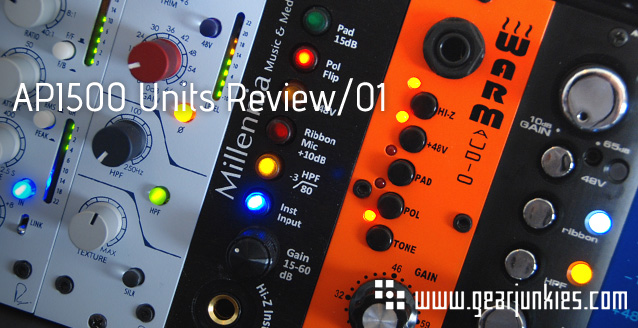Hardware, and with that in mind, modules like the 500 series rack modules used to be the territory of the ‘high-end’ audio gear manufacturers. However, lately we saw a rising availability of these 500 series modules across the board (so to speak). We thought it would be a good plan to look into these 500 series modules and try out some of these modules and see what we would think of these.

API500 systems and DAWs
It’s not like the api 500 systems are brand new. They have been around for decades albeit in a niche market. The last few years they started to become cheaper and more manufacturers introduced new units. This is causing popularity to less traditional appliances and especially the digital realm of DAWs. To start there are chassis that can hold just two single units and are really easy on the go. Or you can go full blown for a chassis that can hold over ten single-slot units in a 19″rack. There are even analog mixers out there that can hold api500 units. With a steep price of course, and even higher if you want to fill all the slots.
As for the units themselves there are over one hundred units made by various manufacturers. We’d love to test them all but for this test we used these units:
Gracie designs 501
Very clean pre-amp with a nice natural sound. During testing the output was very high, and I had to adjust the AD quite a lot. For ribbon and dynamic mics you can increase the input impedance some more.
While testing I found it makes it sound more subtle. Nice for mics, for use with a DAW the effect seemed limited to me.
Warm Audio WA12
A very warm sounding pre-amp. It has some nice coloring options to give the sound some more grit. For use with a DAW it can have myriad functions.
Millennia HV-35
A very clean sounding pre-amp with a very neutral sound. During testing I noticed the HPF filter caused some phasing. The unit gives sound more presence. This can come in handy with a DAW but not that much.
Rupert Neve 511
A very clean pre-amp with a neutral sound. During testing I noticed the coloring options make you lose some high frequencies which can be nice for working with mics. When using with a DAW you can use this to tame the high digital frequencies of thin-ish sounding softsynths.
Rupert Neve 543
A very clean compressor with all the options you need in a compressor. During testing I noticed that even at high loads the high frequencies don’t ‘cave in’ like many other compressor. When using with a DAW this can add some punch and a little bit more life in your mix.
All these units are mono. There are some stereo units out there but the majority of them are mono. So unlike the standard plugins who support stereo or even surround sound, you have to get the two units or be creative with the mix. For that you should be able to use a plugin that can bounce an effect on a stereo channel twice. Something like a double-freeze plugin or do it the old fashioned way.
Considering their relative small form-factor they are well suited to use in smaller (bedroom) studios. Downside to that is that per device you have a fairly limited area to put knobs, switches and pots. So they tend to be on the small side which can be a bit awkward.
Another advantage would be the cost compared to the traditional 19″ racks. That starts to add up when using more units because they all still fit in a single chassis. And it’s easier to trade used units that everybody with a chassis can use immediately and you can try out units for longer times, swap them again and create your own lineup of units you like to use.
A disadvantage is hooking it up to a DAW that will require some extra ins and outs. The impedances differ quite a lot, so if you are connecting it directly to an AD/DA you may have to improvise. That’s why Aphex thought of a 6 unit 500 rack with USB2 and SPDIF interfacing. That seems a step in the right direction. Hopefully there will be chassis with an option to hook them directly to DB25 analog ins and outs and you can adjust the levels per channel.
Is it worth the hassle and the investment?
It depends per person of course. But if you’re looking for a sound that you cannot find in the box you’ll have to start looking outside the box. Why? Well, even though today’s software plugins are sounding really good, they still don’t match today’s organic sounding electronics, especially when using discrete components.
So the answer would be that if you think plugins don’t cut it for you, you can use 500 modules to color the sound to your liking without spending hours tweaking parameters. Or simply use the best of both worlds by combining both realms to your liking. To that extend an API500 rack is like a combination of single instance effects you can use in a DAW and get the results you like.
(This review/write up is the first of a series.)

